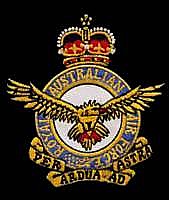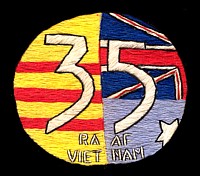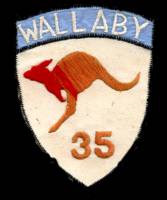
RAAF CARIBOU RESCUED FROM UNDER NOSE OF VIETCONG
Pride in their ability and a challenging situation turned a “black day” for the RAAF’s Caribou Squadron Vietnam into a success story which echoes the achievements of RAAF men in other wars.
It started with a Caribou of No. 35 Squadron Vietnam, crashing while landing at the tiny Special Forces Camp at Ba To, 40 miles south of Da Nang. Communications are so poor throughout Vietnam that it was not until early evening, six hours after the crash, that the Squadron’s Commanding Officer, Wing Commander Charles Melchert, knew anything of the accident. The report stated: “Wallaby 03, nosewheel collapsed while landing Ba To, no casualties” and no other information was available.
By first light next day, a Caribou was on its way to Ba To. On board was 35 Squadron’s Engineering Officer, Flight Lieutenant Wally Solomons and ten of his maintenance staff. They took along spares to repair the nosewheel. Three hours flying time brought them over Ba To, where the position of the crashed Caribou prevented them from landing. It had come to rest with the tail section across the centre of the strip, making it impossible to land another aircraft. Worst of all, everything except the nosewheel seemed to be damaged.
The relief Caribou then flew to Quang Nai, a distance of 25 miles where the US Army provided an Iroquois helicopter to ferry people and equipment to Ba To. On the ground at Ba To, Flt Lt Solomons listed the things to be done before the crashed Caribou could be flown out.
The port wing had to be replaced, a new engine was needed, the undercarriage on the port side was a write-off as well as the propellor and both sets of flaps, apart from new tyres, brake drums and radio antennae that had been torn off by the smash. All this to be done to get the Caribou airworthy without the luxury of a hangar or worthwhile maintenance gear which was available at Vung Tau. If these troubles were not enough, Ba To is situated right in the centre of the “Ho Chi Minh Trail”, running down the East Coast of South Vietnam. At this point the trail is as much as five miles wide, running through the hills and valleys around Ba To.
To protect the Caribou from attempted destruction by VC Guerrillas were 12 Special Forces men, the eleven man RAAF maintenance team, three Sea Bees who were building roads in the area, and four Marines whom Wing Commander Melchert had parachuted in to help in an emergency. At night, the aircraft had to be left on the strip between the first barbed wire defence and the second which surrounded the compound.
There are nearly 70 Caribous in operation in Vietnam, but parts are not readily available. After the list of requirements was drawn up by Flt Lt Solomons, the big scrounge began. From Qui Mhon came the flaps and propellor. A Caribou had burned out at Vung Tau and from that wreckage came the wing. The US Army had an engine without accessories and the RAAF had the tyres, brakes and undercarriage. The small items were flown in once the aircraft had been jacked up, the undercarriage shored with wood and the aircraft dragged across the strip to the parking area, clearing the strip for landings. The wing was the biggest problem. It had to be flown into Ba To by a Chinook chopper from Quang Nai because the strip would not take the Hercules that flew it from Vung Tau.
Once all the parts had arrived, the men set to with a will, stripping the damaged wing, replacing the undercarriage and changing the engine. Working in the sun without a hangar made the job harder. At times, temperatures of 127 degrees Fahrenheit were recorded by men working in the wing and engine compartments. The task was made longer too by the fact that a lot of parts were second hand and integrating control cables and linkages wasted valuable time.
“Charlie”, the Vietcong, was not idle. On the third night, a machine gun sprayed the area around the Special Forces Camp and the maintenance men were ordered to the concrete “Last Stand” bunker. There were no further disturbances that night.
On the following night, an infiltrator tried to breach the barbed wire perimeter and tripped a signal flare and once more the RAAF ground crew were ordered to the bunkers by the US Officer in Charge. Around the spot where the flare had been ignited, the Marines let loose with their grenade launchers and peppered the area with 30 rounds.
Next day a VC Claymore mine was found set-up in one of the bunkers. It was removed and harmlessly exploded. To stave off any last day attempt to destroy the aircraft, Flt Lt Solomons dropped hints among the local Vietnamese that the aircraft would take at least 14 days to repair. Towards the end of the sixth day however, after having worked non stop every daylight hour, the Caribou was ready to fly.
Some parts of the aircraft control surfaces were held by chains. The securing points for the flaps had been driven up into the wing by the impact of the crash and a chain had to be passed through them and lashed to the undercarriage to draw them into alignment. The Squadron’s Commanding Officer, Wing Commander Charles Melchert, would only allow himself, his Flight Commander Flt Lt John McDonnell and crewman Corporal M. “Buggsy” Rose on board the Caribou for the take-off. To the relief of everyone, the take-off went without a hitch and with the undercarriage in the “locked down” position they flew all the way back to Vung Tau and safety.
The flaps which were held down by the chains were so close to alignment that they required only two degrees of correction to bring the aircraft into perfect trim.
Back at Vung Tau Flt Lt Solomons was asked what he intended to do now the aircraft was safe. He said; “park it, sleep for two days, and then I will see what can be done to get it flying again on the Wallaby Airlines”.
(This document was re-typed and edited by Ron Cuskelly on 13 January 2007. It is based on an undated and barely legible Press Release headed “Written by Public Relations”. The bare minimum editorial changes have been limited to spelling, grammar and punctuation! The Caribou featured in this incident was A4-173 which is now on display at the Queensland Air Museum, Caloundra.
The date of the crash was 16 August 1966.
This document describes the second of two remarkably similar accidents involving A4-173 in Vietnam. The first incident occurred at Hai Yen on 7 May 1965. The Caribou which had “burned out at Vung Tau” and which had donated a wing to A4-173 was evidently a United States Army example as no RAAF Caribou met its end under the circumstances described.)
Back
Note, Caribou A4-173 is now in the hands of the Queensland Air Museum where it is being rebuilt and maintained for posterity


